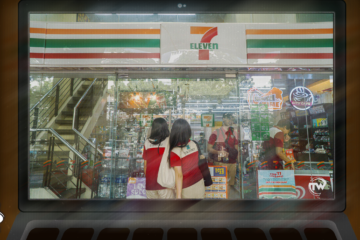
EVERY TUESDAY, Keziah Cinco, an Asian studies senior, leaves her home early to avoid heavy traffic going to the University for an afternoon onsite class.
As someone who lives in Novaliches, Cinco has to travel for two to three hours to go to Manila.
But this came with additional hurdles. She needed to attend her online class first in the morning, which usually ends before lunchtime, giving her only a few hours to prepare.
“The most I can do is compensate, which means I’d need to sacrifice [my time by going] to UST early and […] take morning classes there if I can’t really make it on time,” Cinco said.
Based on the course guidelines released by the Faculty of Arts and Letters (AB) for the second term, only high-stakes assessments are required to be taken onsite. Program heads and professors were given the leeway to decide on the online to onsite class ratio.
Cinco described her Tuesdays as “hassled” by hours of traveling back and forth as she is forced to come to her classes on time and get home before sundown.
But the experience is not unique to Cinco. Some Artlets have expressed similar concerns as they take different learning modalities for different courses, some of which incidentally fell on the same day.
‘Abrupt decision’
During the previous semester, online remained to be the primary learning modality, and onsite classes were only permitted in some professional courses for select programs upon the approval of the UST crisis management committee.
It was only this December that the University announced that academic units may decide on what modality they would use for this term. AB administrators issued a memorandum on the policy on Jan. 12, four days before the official start of the second semester.
Although some students welcomed the gradual return of the pre-pandemic setup, others, like Cinco, admitted having a hard time adjusting. She felt that the Faculty’s announcement of the updated course guidelines was “quite abrupt,” given its limited scope on which aspects of classes may be done face-to-face.
“I think something is not clicking with conducting a class online then the exam is face-to-face. If, in case, the lecture was F2F (face-to-face), then I’d be good with (an) F2F exam,” she said.
“Imagine, for those who live in provinces, going onsite classes on certain dates just for the exam?” she added.
Cinco, however, regards such schedule concerns as part of the “transition period.”
“[A]t this point, I’m just grateful because I’m privileged to have this level of inconvenience compared to those who experience harder struggles in life,” she said.
Just like Cinco, first-year sociology student Jesryl Piñol has concerns over the present hybrid set-up. Some of her classes are done onsite with a weekly or bi-weekly schedule pattern. There are also times that her online class is scheduled between onsite classes on the same day.
“On the days our class has face-to-face classes, we have an online class in between, with a face-to-face class from 10 am to 1 pm, an online class from 1 pm to 4 pm then a face-to-face class again from 4 pm to 7 pm,” Piñol said.
Piñol moved to Manila from North Cotabato after knowing her program would implement a hybrid setup.
“This is hard on our part as we are regularly paying rent every month for school, but will only go to school twice or thrice this semester,” said Piñol, who only has three face-to-face classes this February.
The Philippine Statistics Authority (PSA) recently reported that the country’s inflation hit a 14-year high of 8.7% in January, higher than the 8.1% December 2022 rate. According to PSA national statistician Dennis Mapa, increased housing rental rate was one of the drivers for the swelling inflation rate last month. Rental rates increased by 5% in January, which has not been seen for the past three years at the peak of the COVID-19 pandemic.
Artlets Student Council (ABSC) President Kim Czaccei Dacanay expressed disappointment over what she claimed as the “lack of concrete policies and final instructions” on the final learning mode of students this term. She said students should have been given enough time to prepare for the return of face-to-face classes, noting that some programs only announced plans to hold onsite classes last January.
“Although it is given that we had adjustments (on the hybrid setup), I just hoped that the transition should’ve been smooth (and) the students was given space and time to actually adjust,” Dacanay told The Flame.
“The basic inconsistencies show that the university is not yet prepared as we want it to be (to welcome) students or the Artlets back to the campus,” she added.
Dacanay reiterated the need to ensure a safe and inclusive return to onsite learning, saying the quality of education has been compromised under the online learning mode.
“Classes held via Zoom are super limiting and they are not as inclusive as face-to-face (sessions),” the ABSC president added.
Need for flexibility
Political science senior Gia Karla Martin, who also takes both online and onsite classes on the same day, said the hybrid structure may allow students to be more “flexible.”
“[A]s a senior, I am very eager to go back and study the way we all did back in the pre-pandemic level although I still am adjusting my way through a hybrid form of learning,” she said.
Although Martin believes that students need to be accustomed to taking examinations face-to-face again, she said consideration must still be given to those who could not attend onsite sessions.
“I still see more good than harm since it hones a student’s mental ability while reducing the likelihood of cheating or dependence with online exams. Although [professors] should still be more considerate of those who cannot make it for more valid reasons,” she said.
Despite her stance on onsite learning, Martin acknowledged that not all students might have the same privileges that would allow them to easily adapt to the hybrid setting.
“It might not be the best learning setup for everybody since some wanted to stay in their provinces to lessen their expenses while others wanted to also go and frequently navigate their way throughout the (University),” she said.
Echoing Martin’s views, journalism junior Kimberly Anne Ojeda described hybrid setup to be a “double-edged sword.”
“The common sentiments of my block mates who opted to rent here in Manila are their huge expenses for dorm, commute, and allowance but not maximizing it (their budget),” Ojeda said.
Greater sense of normalcy
Some AB faculty members are convinced that UST is committed to bringing the students towards a greater sense of normalcy.
According to political science professor Froilan Calilung, the early integration of the University into the Blackboard Cloud Campus in 2015 had helped administrators become familiar with hybrid learning. With regard to the concerns about the current setup, Calilung encouraged the students to strike a “win-win solution” and a compromise.
“I think further consultations (of the students) with the University is needed: how we could accommodate these concerns, particularly about mobility, without of course compromising the convenience of our students to the logistics setup,” Calilung told The Flame.
“Ultimately, we also need to understand and balance the reality, on the ground, and at the same time, what is really good for our student body,” he added.
Interdisciplinary Studies chair Asst. Prof. John Manuel Kilatchko said the hybrid learning setup, if done efficiently, is “timely” and would serve the “best interests of Thomasians.”
“Not all learning outcomes can be realistically achieved via full online classes, and this gap can be addressed through hybrid learning,” Kliatchko said.
Noting the experienced adjustment issues by some students and faculty members, Kliatchko said the concerns over varied class schedules “have been addressed” in the behavioral science program.
“We have provided areas for the students to stay in case their onsite and online classes are scheduled consecutively. We provided room assignments for all students even for their online class schedules. The only challenge perhaps would be the internet connection,” Kilatchko said.
“The best way to address emerging concerns is to open lines of communication at all times. I believe this has been our strategy even from the start.”
Asst. Prof. Anna Cielo Perez of the communication department said while the shift to a hybrid setup demonstrates the easing to the “old normal” of conducting on-site tasks, decisions related to it “could have been made earlier.”
“The conflicts in the conducts of LF2F (limited face-to-face) and EVM (enriched virtual mode) classes could have been avoided if the announcement and preparations were made earlier,” she told The Flame.
To address the issue, the communication department “reserved rooms with EVM capabilities” and its professors were instructed to allot grace periods so that students would have ample time to attend onsite classes.
“For example, if one section is having three classes for one day, all the professors could have coordinated through their respective coordinators and chairs to agree on a single class modality to avoid inconvenience for both the students and the faculty members concerned,” Perez said.
Dacanay said the transition to onsite learning has been smooth so far, citing the move of the administration to provide classrooms wifi access. But she believes the UST administration was not proactive enough in terms of resuming in-person classes.
“Other top universities have returned (to onsite learning)…Until now, we are transitioning. Perhaps they did not recognize that the quality of education have declined in different levels,” Dacanay said, referring to the virtual mode of instruction.
Political science sophomore Zildjian Allen Garcia echoed this, saying UST has been “reactive” in handling the shift from enhanced virtual mode to face-to-face learning.
“Especially in a pandemic situation, wherein students and their families (were) hard hit (in terms of) their health and financial means, one of the things AB and UST admin could do is for them to help the students…and to provide ample time and even resources for them to be ready (for) the transition,” Garcia said.
“I think the administration should help students prepare early… before a possible transition to an even bolder full face-to-face setup of learning. This can be done through the continuous collaboration (with) the student councils and the students themselves.”
Garcia also urged UST officials to allow more onsite classes to improve the learning experience of students.
The Flame tried to reach AB Dean Jacqueline Kaw and AB Asst. Dean Melanie Turingan for comment but has yet to receive a response.
Adjustments
While UST has yet to return to full onsite learning, Artlets have adopted measures to mitigate the inconveniences that accompany the hybrid set-up.
Cinco and Piñol said they attend online classes at the library or anywhere with a strong signal whenever they have an onsite class right after.
“[I can] drop by the mall near my house and then go to a resto or coffee shop where the signal is strong,” Cinco said, adding that it could entail additional fees especially on transportation.
“[O]ur class would have to find a place in school with [reliable WiFi connection] to have to do our online class,” Piñol said.
Martin’s section often tries to negotiate possible schedule adjustments or leeway with their professors whenever their onsite classes for the day are squeezed with online classes.
“Our [professors] have been by far very understanding and I’m very thankful. They’ve been very considerate of asking students and offering options in managing the difficulty that may arise due to conflict of schedules,” she said.
Dacanay assured the Artlets that the ABSC would continue to help Artlets cope with the transition to onsite learning.
“Artlets can surely expect change, that is for sure…The Artlets Student Council will be here to make sure the transition is as easy as possible and that no student is left behind,” she said.
According to her, the ABSC constantly conducts surveys and other data collection methods to properly represent the students during the transition phase. Citing the results of the council’s engagements with Artlets, Dacanay said the availability of lodging, commute time, and the availability of uniforms are common challenges that students face.
But the Artlets’ adjustment woes are not about to end just yet.
Late last month, the Office of Vice-Rector for Academic Affairs announced that UST would still implement hybrid learning next academic year despite the continuous decline of COVID-19 infections in the country.
According to a memorandum signed by Vice-Rector for Academic Affairs Prof. Cheryl Peralta dated Feb. 23, no course shall be delivered purely onsite “to ensure that academic staff and students continue to enhance instruction through the use of the UST Cloud Campus and other technology tools acquired by the University.” F



